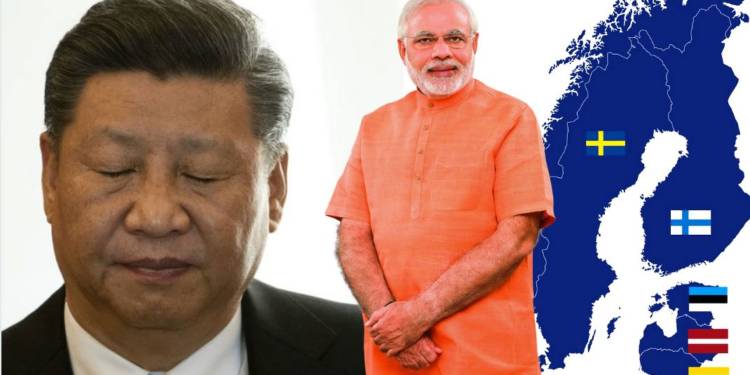The Coronavirus Pandemic has led to a huge backlash against the hawkish Dragon over its irresponsible handling of, or probably involvement in, triggering the COVID-19 Pandemic. Every country and part of the world wants to make this public health emergency China’s Waterloo moment.
There is invariably one country that every nation in the world is turning to in order to counter Chinese hegemony- India. And now the Nordic-Baltic countries, viz. Denmark, Finland, Iceland, Sweden, Norway, Latvia, Estonia, and Lithuania, are also trying to bolster their ties with New Delhi.
The Coronavirus Pandemic has opened up the opportunity for expanding ties between India and the Nordic-Baltic countries. Since March, there have been at least 15 envoy-level meetings attended by ambassadors from every country in the region. according to Sunday Guardian, meetings are held every Friday where bilateral engagements at many levels are discussed and explored among the Nordic and Baltic nations, and India.
Of the eight countries- Denmark, Norway, Sweden, Finland, Iceland are Nordic countries and Estonia, Lithuania, and Latvia are Baltic nations named after the sea that they are coastlines with- the Baltic Sea.
There is immense scope for cooperation and improvement of ties between India and the Nordic-Baltic countries across a range of sectors- Pharma, environment, tourism, education, agriculture and diary. But the ties have been somewhat undervalued and under-explored.
There is a need to understand the renewed importance of the Nordic-Baltic nations in the present geopolitical scenario.
warming is opening up the Arctic to greater human activity, and the Dragon wants to exploit it for securing new transport links to support its gigantic exports-based economy.
The Arctic was earlier an area of Soviet influence and now it is becoming an area of Chinese influence. What the phenomenon of Global Warming has also done is open up the resource-rich Arctic Region for exploration and development.
In this context, Beijing wants to find a connectivity route and invest heavily in this part of the world. China is using what is being described as the Russia-China axis to connect the Pacific to the Atlantic and take a firm grip of the Eurasia region.
In fact, the three Baltic countries will be a key for transportation hubs in this region and Beijing is investing heavily in the Baltic Sea Region. Latvia, Lithuania and Estonia, are all parts of the Belt and Road Initiative (BRI) but recent developments show that they want to balance out things by looking towards India
In recent times, Sweden’s fights have intensified with China as Stockholm has been locked in diplomatic tussles with the Dragon since 2015.
Similarly, Estonia recently released an intelligence report warning about growing Chinese influence, following which it has been facing pressure from Beijing to amend the report.
Going ahead, the Baltic Sea Region is going to become a transportation hub, as the consequences of global warming in the region will mean that the maritime region stays frozen for lesser time. Consequently, the ports will be operational for a longer time throughout a year.
India and the Nordic-Baltic nations realise that they have a lot to offer each other. India can balance out the perils of growing Chinese influence and Beijing’s ability to access these countries far more easily as both China and Russia have aligned to connect the Pacific with the Arctic.
New Delhi on the other hands has strategic gains to make. By occupying some of China’s space in the Nordic-Baltic region, India will gain access to newer markets.
Moreover, India has a lot to gain from cooperation across several sectors, such as agriculture. The ruling BJP government in India has recently unleashed agricultural reforms by diluting the APMC and deciding to amend the Essential Commodities Act.
India has lessons to learn from Sweden and Denmark on how to eliminate middlemen and run farm cooperatives.
In the dairy sector, India is the world’s biggest milk producer, but India’s dairy sector is not as varied as the Nordic region. Recently, PM Modi had said that India has the scale, while Denmark has the skills.
New Delhi wants to look at ‘Dairy diplomacy’ with Denmark in this perspective.
Other sectors where India wants to explore partnerships with the Nordic-Baltic nations are solid waste management and green energy. Cooperation in these sectors might get that much of an impetus in a post-Coronavirus world.
Moreover, India’s booming generic medicines industry can also find an opportunity to access markets like Denmark, Sweden, and Norway as part. It must be kept in mind that these nations are anyway trying to get rid of over-dependence on Beijing as far as healthcare is concerned.
In this sense, India and the Nordic-Baltic countries are opening up many new avenues and sectors for diplomatic engagement with a shared vision- cutting China to size and balancing it out by offering India a level-playing field in the region so that the Nordic-Baltic region doesn’t become a region of exclusive Chinese influence.
